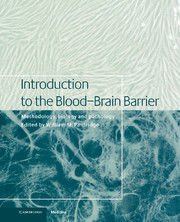Book contents
- Frontmatter
- Contents
- List of contributors
- 1 Blood–brain barrier methodology and biology
- Part I Methodology
- 2 The carotid artery single injection technique
- 3 Development of Brain Efflux Index (BEI) method and its application to the blood–brain barrier efflux transport study
- 4 In situ brain perfusion
- 5 Intravenous injection/pharmacokinetics
- 6 Isolated brain capillaries: an in vitro model of blood–brain barrier research
- 7 Isolation and behavior of plasma membrane vesicles made from cerebral capillary endothelial cells
- 8 Patch clamp techniques with isolated brain microvessel membranes
- 9 Tissue culture of brain endothelial cells – induction of blood–brain barrier properties by brain factors
- 10 Brain microvessel endothelial cell culture systems
- 11 Intracerebral microdialysis
- 12 Blood–brain barrier permeability measured with histochemistry
- 13 Measuring cerebral capillary permeability–surface area products by quantitative autoradiography
- 14 Measurement of blood–brain barrier in humans using indicator diffusion
- 15 Measurement of blood–brain permeability in humans with positron emission tomography
- 16 Magnetic resonance imaging of blood–brain barrier permeability
- 17 Molecular biology of brain capillaries
- Part II Transport biology
- Part III General aspects of CNS transport
- Part IV Signal transduction/biochemical aspects
- Part V Pathophysiology in disease states
- Index
15 - Measurement of blood–brain permeability in humans with positron emission tomography
from Part I - Methodology
Published online by Cambridge University Press: 10 December 2009
- Frontmatter
- Contents
- List of contributors
- 1 Blood–brain barrier methodology and biology
- Part I Methodology
- 2 The carotid artery single injection technique
- 3 Development of Brain Efflux Index (BEI) method and its application to the blood–brain barrier efflux transport study
- 4 In situ brain perfusion
- 5 Intravenous injection/pharmacokinetics
- 6 Isolated brain capillaries: an in vitro model of blood–brain barrier research
- 7 Isolation and behavior of plasma membrane vesicles made from cerebral capillary endothelial cells
- 8 Patch clamp techniques with isolated brain microvessel membranes
- 9 Tissue culture of brain endothelial cells – induction of blood–brain barrier properties by brain factors
- 10 Brain microvessel endothelial cell culture systems
- 11 Intracerebral microdialysis
- 12 Blood–brain barrier permeability measured with histochemistry
- 13 Measuring cerebral capillary permeability–surface area products by quantitative autoradiography
- 14 Measurement of blood–brain barrier in humans using indicator diffusion
- 15 Measurement of blood–brain permeability in humans with positron emission tomography
- 16 Magnetic resonance imaging of blood–brain barrier permeability
- 17 Molecular biology of brain capillaries
- Part II Transport biology
- Part III General aspects of CNS transport
- Part IV Signal transduction/biochemical aspects
- Part V Pathophysiology in disease states
- Index
Summary
Introduction
The importance of blood–brain barrier (BBB) integrity has long been recognized and BBB permeability has been measured using invasive tracer techniques in experimental animals. Since the development of positron emission tomography (PET), non-invasive measurement of BBB permeability in humans has become feasible. Although the integrity of the BBB in man has also been examined using contrast CT, MRI, and radioscintigraphy, the results are mostly qualitative, i.e. they do not provide the permeability–surface area product (referred to simply as permeability in this chapter) in terms of ml/min/g. Without a quantitative measure, BBB changes due to disease progression, treatment, and pharmacological interventions cannot be easily assessed. PET has been successfully employed to examine BBB permeability in man in various diseases and pharmacological interventions (Brooks et al., 1984; Hawkins et al., 1984; Lockwood et al., 1984; Iannotti et al., 1987; Schlageter et al., 1987; Pozzilli et al., 1988; Ott et al., 1991; Black et al., 1997). In the following, the basic principles used in these techniques are introduced and the procedure, requirements, and typical results are reviewed.
Basic principles
For a systemically administered tracer to get to the extra-vascular space of the brain tissue, the tracer needs to be delivered first to the capillaries in the brain tissue by cerebral blood flow (or perfusion) (CBF) and then transported across the BBB.
- Type
- Chapter
- Information
- Introduction to the Blood-Brain BarrierMethodology, Biology and Pathology, pp. 140 - 146Publisher: Cambridge University PressPrint publication year: 1998
- 1
- Cited by



